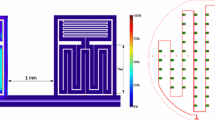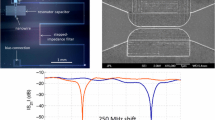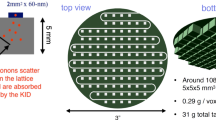Abstract
We present a status of the development of microwave kinetic inductance detectors (MKIDs) for a detection of athermal phonons in a substrate. The energy deposited in the substrate is converted to athermal phonons. Athermal phonons arriving at the surface can break Cooper pairs in the MKIDs which are formed as a thin superconducting metal layer in the substrate surface. By counting the number of Cooper pairs broken and measuring the phonon arrival times, we can measure the amount of deposited energy and its position. MKIDs are suitable for the frequency-domain multiplexing readout, which enables us to readout hundreds of pixels simultaneously and, hence, to detect athermal phonons with a large detection efficiency. We fabricated MKIDs with a combination of aluminum and niobium on a silicon substrate, and then irradiated it with \(\alpha \) particles from an \(^{241}\)Am source. We detected phonons and made a rough estimation of the phonon propagation velocity of 1.1–1.3 km/s. We found that a thin insulator layer can block the phonon propagation from the substrate to the thin metal layer.
Similar content being viewed by others
Avoid common mistakes on your manuscript.
1 Introduction
The energy deposited by the particles in a substrate can be measured using superconducting detectors through the athermal phonon detections. The detection technique can in principle provide a large acceptance with the energy resolution better than that of the semiconductor detectors, which is about 2 % for 5.9 keV X- rays [1]. Kurakado et al. [2] successfully detected such phonons using superconducting tunnel junctions (STJ) with a Si substrate, and obtained the energy resolution of 1.2% for \(5.9\) keV X-rays with the effective detection area larger than 10 mm\(^2\). The STJ detectors, however, are difficult for the multiplexing readout. Kurakado et al. [2] used four series-junctions, each consisting of 512 STJs, with four charge-sensitive preamplifiers. The small number of readout channels would deteriorate the position resolution, hence may reduce the energy resolution. On the other hand, microwave kinetic inductance detectors (MKIDs) are suitable for multi-channel readout as they make use of the frequency domain multiplexing. Hundreds of channels can be read out through a single co-axial cable with a HEMT amplifier. Hence, MKIDs enable us to detect the athermal phonons with a large effective area and a large number of pixels, which may improve the position and energy resolutions. Moore et al. [3] have recently demonstrated the energy and position resolved phonon-mediated detection in a silicon substrate using MKIDs and obtained the energy resolution of 1.8 % at 30 keV. Such a detector can be used for various applications: X/\(\gamma \)-ray astronomy, dark matter searches and material science.
2 Fabricated MKIDs and Experimental Setup
We fabricated MKIDs in the KEK clean room facility. The substrate was made of high purity silicon with a thickness of 300 \(\mu \)m. The MKIDs were made of niobium for the quarter wave-length resonators, microwave feed line and a ground plane. The aluminum fins are attached at the end of the resonators where the resonators are connected to the ground. In this design, the resonant alternative electric current becomes maximal at the aluminum fin where the MKID sensitivity is maximal, since the sensitivity is proportional to the square of the magnitude of an electric current. The fin size is 0.3 \(\times \) 0.1 mm\(^{2}\). The MKIDs we fabricated consist of ten pairs of resonators, and each pair consists of a common aluminum fin connected to two niobium resonators. At the center of the fin, the niobium ground plane is connected. Both metal layers were deposited by a sputtering machine; the niobium (aluminum) layer has a thickness of 300 nm (200 nm). The MKID pattern was formed using a lithography technique with a lift-off method. Figure 1 shows the MKID design and a microscopic picture of the fabricated device.
Top Design of the MKIDs. The detector consists of ten pairs of resonators. Each pair consists of a common aluminum fin connected to both ends of the niobium quarter wave-length resonators. The size of the fin is 0.3 \(\times \) 0.1 mm\(^{2}\). The resonator numbers are assigned from upper left to right (1–10) and lower left to right (11–20). Middle Zoomed in picture of the design. Bottom Microscopic picture of the fabricated device. (Color figure online)
The device was mounted on a ceramic plate by applying the GE 7031 vanish, and covered by a brass housing with a hole through which \(\alpha \) particles were irradiated. The device was cooled to 0.3 K using a \(^3\)He sorption refrigerator. The resonant peaks were searched for by using a vector network analyzer and found to be distributed from 4 to 5 GHz with a 50 MHz spacing as expected, except for one missing resonance, corresponding to 95 % production yield. Figure 2 shows the observed resonant peaks. The Q-values of the resonant peaks were 2–5 \(\times 10^4\).
Resonant peaks measured by a vector network analyzer. The numbers correspond to the resonators of the top figure in Fig. 1. (Color figure online)
3 Results
We irradiated 5.5 MeV \(\alpha \) particles from an \(^{241}\)Am source sealed by a thin 100 \(\mu \)g/cm\(^2\) gold foil. The source was placed in front of the MKID metal layer as shown in Fig. 3; \(\alpha \) particles emitted from the source penetrate the MKID metal layer and stop at the silicon substrate. No collimator was placed so that \(\alpha \) particles were irradiated on the whole of the MKID surface. We applied a homodyne readout scheme. Two resonant frequency microwaves were generated by signal generators. Each microwave was divided into two, one of which was combined with another microwave and fed to MKIDs. The other was further divided into two as the LO inputs to mixers. The microwaves from the MKIDs were amplified by a cryogenic HEMT amplifier and room temperature amplifiers, and divided into two. Each was further divided through a hybrid circuit which made a relative \(\pi /2\) phase shift for the two outputs. The outputs were injected into the mixers as RF inputs. The mixer’s IF outputs were the In-phase (I) and Quadrature (Q) signals. The two resonator’s I/Q signals were recorded by an oscilloscope. Figure 3 shows the observed \(\alpha \) particle I/Q pulse shapes for three different combinations of the resonators.
Left Experimental setup of the \(\alpha \) particle irradiation on our detector, and location of the resonators used for the \(\alpha \) particle detections. Right The observed \(\alpha \) particle pulse shapes for different combinations of two resonators’ I/Q signals. The numbers correspond to the resonator locations in the left figure. The solid curves are fitted and dotted lines are the pulse shapes obtained by applying a digital filter. (Color figure online)
We fitted the pulse shapes by using a model function [4]:
where the fitted parameters are the time constants (\(\tau _\mathrm{d}\) and \(\tau _\mathrm{i}\)), the signal amplitude (\(A\)), the phonon arrival time (\(t_0\)) and the baseline level (\(B\)). We compare the \(t_0\) values for each combination and find the phonon arrival time differences are \(-0.2\), \(+1.4\) and \(+2.4\) for resonator combinations of 08 and 18, 08 and 19, and 08 and 20, respectively, in a unit of \(\mu \)sec with a measurement error of \(\pm 0.4~\mu \)sec. As we only readout two resonators simultaneously, we could not identify the \(\alpha \) particle irradiated position. If we assume that \(\alpha \) particles were irradiated at the position of the resonator which gave a higher pulse height, we may be able to estimate the propagation velocity of athermal phonons. From the distance between the adjacent resonators of 1.6 mm, we make a rough estimation of the velocity to be 1.1–1.3 km/s, which is comparable to the results obtained by Swenson et al. [5].
We fabricated a detector made of niobium only and irradiated \(\alpha \) particles on it. No coincident events were found, but only single resonator responses were observed. This phenomenon may come from the fact that niobium has a larger energy gap than aluminum, and therefore niobium is less sensitive to phonons from the substrate than aluminum.
We have found that the I/Q signal position on the two-dimensional I-Q plane moves not only to the phase shift direction but also to the radial (dissipative) direction, and the resonant circle is distorted. To measure the energy detected, we need to calibrate the phase and amplitude shift by taking into account a possible non-linearity. That may require the treatment introduced by Calvo et al [6].
In order to confirm the athermal phonon detections from the substrate, we inserted a thin 50 nm Al\(_2\)O\(_3\) insulator layer underneath the aluminum fin layer, which is expected to stop phonons from the substrate [7]. The left figure in Fig. 4 shows a side-view structure of the MKID. The right figures are oscilloscope images showing the observed I/Q signals of a pair of two resonators. We saw no coincidence of signals for any resonator combinations, even for the resonators having a common fin. The observed signals were supposed to be generated by \(\alpha \) particles hitting the aluminum fins directly. The fin is connected to the ground plane at its middle position. The fact that only single resonator responded to \(\alpha \) particles may imply not only that phonons from the substrate were blocked by the insulator layer, but also that the quasi-particles generated in the either side of the fin did not diffuse to the other side. The latter may be caused by a short lifetime of quasi-particles in the aluminum fin in our detector. This may be supported by the measured signal decay time of \(2.2\pm 0.2~\mu \)sec, which is much shorter than the expected quasi-particle lifetime in aluminum at 0.3K (20 \(\mu \)sec) [8, 9], and is rather comparable to the resonator response time \(Q/\pi f_0\) = 2.4 \(\mu \)sec, where \(Q\) and \(f_0\) are the measured Q-value (\(3\times 10^4\)) and the resonant frequency (4.34 GHz), respectively. We are now investigating why the measured quasi-particle lifetime in aluminum was much shorter than the expectation.
Left Side view structure of the phonon blocking MKIDs. A thin 50 nm Al\(_2\)O\(_3\) layer is inserted between the aluminum fin and the silicon substrate. Right Oscilloscope images of the observed I/Q signals of \(\alpha \) particles for a pair of two resonators. A response of only either of the resonators is seen. (Color figure online)
This phonon blocking technique may be usable to reduce phonon contamination from the substrate produced by cosmic rays or environment radioactivity for direct particle and electromagnetic wave detections, provided that the level of noise originating from the insulator layer is smaller than the requirements of the measurements.
4 Conclusions
We have developed MKIDs for the detection of phonons from the silicon substrate. For the MKID fabrication, we used niobium for the microwave feed-line, resonators and the ground plane, and aluminum for the fins where the detection sensitivity is maximal. The MKIDs were formed on a 300 \(\mu \)m thickness high purity silicon substrate using a lithography technique. Phonons produced by \(\alpha \) particles in the substrate were observed successfully. We made a rough estimation of the phonon propagation velocity to be 1.1–1.3 km/s from the phonon arrival time differences. A thin insulator layer is confirmed to be valid for the blocking of the phonons from the substrate, which may be usable for direct particle and electromagnetic wave detections to reduce phonon contamination from the substrate.
References
G. Gauglitz, T. Vo-Dihn (eds.), Handbook of Spectroscopy (Wiley Online Library, Hoboken, 2005)
M. Kurakado et al., Nucl. Instr. Methods A 621, 431 (2010)
D.C. Moore, S.R. Golwala, B. Bumble, B. Cornell, P.K. Day, H.G. LeDuc, J. Zmuidzinas, Appl. Phys. Lett. 100, 232601 (2012)
H. Spieler, Semiconductor Detector Systems (Oxford Science Publications, Oxford, 2005)
L.J. Swenson, A. Cruciani, A. Benoit, M. Roesch, C.S. Yung, A. Bideaud, A. Monfardini, Appl. Phys. Lett. 96, 263511 (2010)
M. Calvo et al., A &A 551, L12 (2013)
A. Poelaert, A. Peacock, N. Rando, P. Verhoeve, P. Videler, J. Appl. Phys. 79, 2574 (1996)
H. Sato et al., IEEE Trans. Appl. Supercond. 9(2), 4475 (1999)
S.B. Kaplan, C.C. Chi, D.N. Langenberg, J.J. Chang, S. Jafarey, D.J. Scalapino, Phys. Rev. B 14, 4854 (1976)
Acknowledgments
The authors would like to thank KEK Detector Technology Project. H. I is supported in part by the Grant-in-Aid for Challenging Exploratory Research No. 24654068 and by the Grant-in-Aid for Young Scientists (A) No. 22684009.
Author information
Authors and Affiliations
Corresponding author
Rights and permissions
Open Access This article is distributed under the terms of the Creative Commons Attribution License which permits any use, distribution, and reproduction in any medium, provided the original author(s) and the source are credited.
About this article
Cite this article
Ishino, H., Kibayashi, A., Hattori, K. et al. Development of Microwave Kinetic Inductance Detectors for a Detection of Phonons. J Low Temp Phys 176, 161–167 (2014). https://doi.org/10.1007/s10909-013-1025-0
Received:
Accepted:
Published:
Issue Date:
DOI: https://doi.org/10.1007/s10909-013-1025-0








